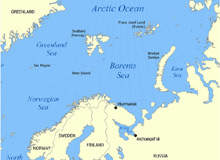
The Shtokman field, which is also known as the Stockman field, is a Russian-controlled gas development in the centre of the Russian sector of the Barents Sea, about 370 miles (500km) north of the Kola Peninsula. The gas field is estimated to be one of the world’s largest natural gas deposits with reserves estimated at 3.8 trillion cubic metres of natural gas and about 37m tonnes of gas condensate.
Gas was discovered in this area in 1988, but the resource was not developed earlier because the sea varies in depth from 320m to 340m and the extreme cold conditions of the Arctic (gas deposits lie in four main layers and the reservoir depth is between 1,900m and 2,300m). One of the great hazards for production platforms will be iceberg collision (one million tonnes), which will be countered by using floating removable platforms.
The company with the rights to explore for and produce gas from this field is Sevmorneftegaz, which is a subsidiary of Gazprom. In order to develop the field Gazprom needed the expertise and investment of foreign oil companies and a special purpose vehicle (SPV), called the Shtokman Development Company, was set up to develop and exploit the field.
Shtokman Development was formed in February 2008 (Swiss registered) and the ownership is split up as follows: Gazprom (51%), Total (25%) and StatoilHydro (24%). When phase one is completed Total and StatoilHydro are expected to transfer their shares to Gazprom.
The Shtokman field was expected to come onstream by 2013-15 and development costs were estimated at between $12 and $25bn for the first phase ($50bn overall investment). The first gas was expected in 2013 at 11bcm a day along with 205,000t of gas condensate per year. First LNG was expected in 2014 at 7.5MTA.
However, in February 2010, the project development schedule was postponed for three years due to a decrease in demand for gas in European markets. Gas production from the facility will now start in 2016. The first LNG production has also been postponed until 2017 due to changes in the targeted US LNG market.
The investment decision for the field development will be made by March 2011, while for LNG the decision will be made in December 2011.
Four phases in total are scheduled for full field development, which will deliver 71.1bcm per year, 30MTA of LNG and 600,000t of gas condensate per year over a 50-year period.
Shtokman projects
Among the great problems with developing such a resource are where the gas will be marketed and how to transport it. Sevmorneftegaz and the Shtokman Development Company are working on the phase I development (design and construction) of the Shtokman infrastructure.
This will include a production complex, a pipeline network and an LNG plant. The gas was initially destined for the US market as LNG export but Gazprom has also indicated that it wants to export some of the produced gas to Europe via the Nord Stream pipeline and this will require a pipeline spur from the Shtokman field to the Murmansk Oblast and then via Kola peninsula to Volkhov in the Leningrad Oblast.
An LNG production facility is also planned and will be constructed in the village of Teriberka, which is situated about 72 miles (120km) east of Murmansk.
Planning and design
Front-end engineering and design (FEED) work for the project has been divided between three companies. The onshore transportation and gas processing technology, including an LNG plant, will be prepared by Technip (contract awarded in 2008).
The onshore facilities will include an offshore gas pipeline terminal, a gas treatment plant, an LNG train with a capacity of 7.5m tpy and an export plant for the Russian and European markets.
Technip will also work on two additional contracts; the first is to establish a set of project standards and the second to assist the Shtokman Development Company with the definition of site preparation works.
In addition DORIS Engineering has been asked to prepare the FEED of the subsea production system and the offshore technology platform. JP Kenny (subsidiary of Wood Group) in conjunction with Rubin Design Bureau and Giprospetsgaz (subsidiary of Gazprom) has been asked to design the 370 mile (600km), 44in (1,120mm) subsea pipeline from the Shtokman field to south of Murmansk.
Platforms
The project will initially use two platforms and these will be assembled by the Sevmorput (Shipyard No 35) shipyard in Murmansk, which will also construct ice-protection cones for each platform. The platform foundations will be constructed by the Vyborg Shipyard in Vyborg, Russia, and the upper platform part will be constructed by Samsung Heavy Industries in Korea.
The assembly of the Shtokman platforms was scheduled to take place in 2010. In addition Dockwise Shipping BV was contracted ($84m over three years) by the Vyborg Shipyard to transport the two topside structures (22,000t each) from Geoje Island, Korea, to the assembly locations in Murmansk harbour and to assist in installing the units on semi-submersible hulls, using the float-over technique.
The first topside was scheduled to be loaded at the end of April 2010 for installation in August 2010 and the second to be loaded in October 2010 for installation in February 2011.



